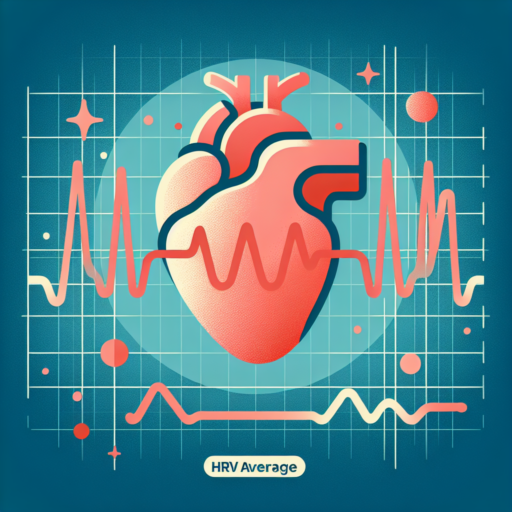What is HRV and Why It Matters?
Heart Rate Variability, or HRV, is a measure of the variation in time between each heartbeat. This metric is considered highly indicative of an individual’s cardiovascular and autonomic nervous system health. Unlike the constant rhythm many assume is ideal for heart health, a higher HRV suggests a robust and responsive cardiac system capable of adapting to stress, physical demands, and even changes in the environment more efficiently.
Understanding the significance of HRQ is vital for both athletes and the general population. For athletes, tracking HRV can guide training schedules, indicating when to push harder or take a rest day to avoid overtraining and potentially enhance performance. For the everyday person, monitoring HRV can provide insight into stress levels, overall wellbeing, and can even predict potential health issues before they become severe, offering a chance to take proactive steps towards maintaining health.
Incorporating HRV monitoring into daily health routines can be done through wearable technology and specialized apps designed to record and analyze heartbeat data. This accessibility allows individuals to gain deeper insights into their body’s signals, promoting a more informed approach to health and fitness. By understanding and responding to HRV readings, people can optimize their health strategies, aiming for a higher quality of life and potentially reducing the risk of stress-related health issues.
Understanding the Basics of HRV
When delving into the realm of heart health and wellness, Heart Rate Variability (HRV) emerges as a crucial indicator. HRV measures the variation in time between each heartbeat, which is often overlooked in traditional heart rate monitoring. This variability is not only a marker of physical fitness but also a window into the autonomic nervous system’s functionality, providing insights into stress levels, recovery status, and overall well-being.
The significance of HRV lies in its ability to offer an in-depth analysis of our body’s response to stress and relaxation. A higher HRV indicates a robust and resilient heart capable of adapting quickly to changes, signifying a healthy balance between the sympathetic and parasympathetic nervous systems. Conversely, a lower HRV can signal stress, fatigue, or underlying health issues, making it a vital tool for monitoring and improving heart health.
To accurately monitor HRV, various methods and devices are now available, ranging from wearable technology to specialized medical equipment. By regularly tracking HRV, individuals can gain valuable insights into how their lifestyle, exercise, and relaxation techniques affect their heart rate variability. This opens the door to personalized health and fitness plans that can significantly enhance an individual’s quality of life and cardiovascular health.
How to Measure Your HRV Accurately
Measuring Heart Rate Variability (HRV) accurately is crucial for anyone looking to optimize their health and fitness routines. HRV, a measure of the variation in time between each heartbeat, is an insightful marker of your autonomic nervous system’s balance. Understanding how to track this vital sign accurately can provide invaluable insights into your overall wellbeing, stress levels, and recovery status.
Use the Right Equipment
Choosing the right equipment is the first step in accurately measuring your HRV. Opt for FDA-approved heart rate monitors or smartwatches that offer HRV measurements. These devices should have a high sampling rate to accurately capture the minute variations in your heartbeats. Brands like Garmin and Polar have models specifically designed for this purpose, ensuring you get reliable data for your analysis.
Consistent Measurement Timing
For HRV readings to be meaningful, they need to be taken consistently. The best time to measure your HRV is first thing in the morning, right after waking up. This practice minimizes the impact of external variables like food intake, physical activity, and stress, providing a baseline that’s more reflective of your body’s natural state. Recording your HRV at this time ensures that you are comparing ‘apples to apples’, making your longitudinal data more reliable and actionable.
Understanding and accurately measuring your HRV can seem daunting at first, but by using the right tools and maintaining a consistent routine, you can unlock significant insights into your health. This understanding allows for smarter training decisions, optimized recovery, and a well-balanced lifestyle. Start with these foundational steps, and ensure that your method of measuring HRV aligns with best practices for accuracy and reliability.
No se han encontrado productos.
What Is a Good Average HRV?
Understanding your Heart Rate Variability (HRV) can be a step forward in monitoring your physical fitness and overall well-being. A good average HRV varies significantly among individuals, making it somewhat challenging to pinpoint a universal ‘good’ score. Instead, it’s beneficial to focus on personal baselines and progress.
Age, fitness level, and lifestyle choices are critical factors that influence HRV. Generally, a higher HRV indicates better cardiovascular fitness and stress resilience. Younger individuals tend to have higher variability compared to older adults, and athletes often record higher HRV scores than non-athletes due to their conditioned nervous systems.
Personal tracking over time can provide the most value when determining a good average HRV for oneself. Utilizing HRV tracking apps or devices allows for observing trends and understanding personal health and fitness levels. Notably, sudden drops in HRV may signify stress, illness, or overtraining, warranting a closer look into recovery and wellness practices.
Factors Affecting Your HRV Average
Understanding the factors that influence your Heart Rate Variability (HRV) average is crucial in assessing your body’s health and readiness. HRV is a powerful metric that reflects the balance and adaptability of your autonomic nervous system, offering insights into your stress levels, recovery status, and overall well-being. Various physiological and external factors can significantly impact your HRV, making it essential to recognize and manage these aspects for optimal health.
Physical Activity and Recovery
Physical activity plays a pivotal role in influencing your HRV average. Regular exercise enhances HRV by improving your heart’s efficiency and your autonomic nervous system’s adaptability. However, the type, intensity, and duration of exercise can have varying effects. High-intensity workouts may temporarily reduce HRV due to increased stress on the body, highlighting the importance of balanced training and adequate recovery periods. Recovery is equally crucial, as overtraining without sufficient rest can lead to a decrease in HRV, signaling potential health issues or burnout.
Sleep Quality
The quality of your sleep significantly affects your HRV average. Deep, restorative sleep enhances HRV, indicating a relaxed, parasympathetic state. In contrast, poor sleep patterns, such as late nights and sleep disruptions, can lead to lower HRV levels. This reduction is a result of increased sympathetic activity and decreased parasympathetic influence, reflecting higher stress and reduced recovery. Prioritizing good sleep hygiene practices, like maintaining a consistent sleep schedule and creating a conducive sleep environment, can therefore improve HRV.
Stress and Emotional Well-being
Chronic stress and emotional turmoil can significantly lower your HRV average, hinting at an overactive sympathetic nervous system and a body that’s in constant «fight or flight» mode. Techniques for managing stress, such as mindfulness, meditation, and deep breathing exercises, can effectively increase your HRV by promoting a state of relaxation and recovery. Additionally, seeking support for emotional well-being through therapy or social connections can foster an environment that’s conducive to improved HRV and overall health.
Improving Your HRV: Practical Tips and Tricks
Heart Rate Variability (HRV) is a crucial metric for gauging your heart’s health and overall well-being. A greater HRV indicates a more adaptable cardiovascular system, which can be beneficial for your physical and mental health. Improving your HRV can be achieved through several lifestyle adjustments and practices that enhance your heart’s rhythm and resilience.
Develop a Consistent Exercise Routine
Regular physical activity is paramount for boosting your HRV. It’s not about extreme workouts, but consistency and variety. Incorporating a mix of aerobic exercises, strength training, and flexibility workouts can optimize heart health and consequently, improve HRV. Aerobic exercises such as running, cycling, or swimming are particularly beneficial because they compel your heart to pump blood more efficiently, enhancing cardiovascular resilience.
Prioritize Quality Sleep
Adequate rest is another cornerstone of improving HRV. Poor sleep quality and irregular patterns can lead to a decrease in HRV, signaling stress and an overworked heart. Aim for 7-9 hours of uninterrupted sleep, establishing a consistent bedtime routine to enhance sleep quality. Techniques such as limiting screen time before bed, sleeping in a dark, cool environment, and avoiding caffeine late in the day can contribute to better sleep and, as a result, a healthier HRV.
Implement Stress-Reducing Practices
Managing stress is crucial for improving your HRV. Chronic stress puts a strain on your heart, reducing HRV and your adaptive capacity to handle different scenarios. Incorporating stress-reduction techniques like deep breathing exercises, meditation, or yoga can significantly enhance your HRV by calming the nervous system and reducing stress levels. Regular practice can lead to long-term benefits for both your heart’s rhythm and overall well-being.
HRV Trends: What Your Average HRV Says About Your Health
Understanding your Heart Rate Variability (HRV) is crucial in unlocking insights into your overall wellness and fitness levels. The concept of HRV trends and what your average HRV can reveal about your health is an area of growing interest among both healthcare professionals and fitness enthusiasts. HRV, the variation in time between each heartbeat, is an excellent window into the autonomic nervous system and how it manages stress, recovery, and resilience.
Deciphering Your Average HRV Score
Typically, a higher HRV indicates better cardiovascular fitness and stress management capabilities. It signifies a balanced autonomic nervous system, able to adapt and respond to stress efficiently. On the flip side, a consistently low HRV could point towards excessive stress, fatigue, or underlying health issues. It is why tracking your average HRV, along with understanding the factors that influence it, can be instrumental in guiding lifestyle choices and interventions.
Factors Influencing HRV Trends
- Physical Activity: Regular moderate exercise can improve HRV, while excessive high-intensity workouts might lower it temporarily.
- Stress Levels: Psychological stress and anxiety can significantly decrease HRV, highlighting the importance of stress management practices.
- Sleep Quality: Deep, restorative sleep, and consistent sleep patterns enhance HRV, while sleep disturbances can disrupt it.
Individually, these elements play a critical role in shaping your HRV trends. By monitoring changes in your average HRV, you can gain invaluable insights into your body’s response to lifestyle changes, health interventions, and stress management techniques. It demonstrates the intertwining relationship between HRV and overall health, putting emphasis on holistic wellness practices.
Common Misconceptions About HRV Averages
When discussing Heart Rate Variability (HRV), a common topic that comes up is the HRV average. There are several misconceptions surrounding what HRV averages signify and their implications for health and fitness. Let’s explore some of these misunderstandings.
1. High HRV Always Indicates Better Health
One of the most prevalent misconceptions is that a higher HRV average is always indicative of better health or fitness levels. While it’s true that HRV can reflect the body’s resilience and ability to manage stress, an excessively high HRV can sometimes suggest potential health issues or an incorrect response to stress. Thus, context matters significantly, and HRV should be viewed as part of a broader assessment of well-being.
2. Low HRV Means Poor Fitness
Similarly, there’s a common misunderstanding that a low HRV automatically suggests poor fitness or health status. However, HRV is highly individualistic and can be influenced by a myriad of factors including genetics, lifestyle, and even the time of day when measurements are taken. Consequently, interpretations of HRV should be personalized and consider long-term trends rather than isolated readings.
In summary, while HRV averages offer valuable insights into an individual’s physiological state, they carry a complexity that requires careful interpretation. Myths that categorize HRV readings into simply ‘good’ or ‘bad’ overlook the nuances of autonomous nervous system function and its relationship with overall health. Therefore, a more nuanced understanding is essential for individuals looking to leverage HRV data effectively.
Comparing HRV Average by Age and Gender
Understanding the Heart Rate Variability (HRV) average by age and gender offers fascinating insights into cardiovascular health and overall wellness. HRV measures the variation in time between each heartbeat, a critical indicator of the autonomic nervous system’s functioning and an individual’s stress and recovery status. This variance in heart rate plays a pivotal role in personal health monitoring, especially when compared across different demographic groups.
Age significantly influences HRV, with varying ranges considered normal at different life stages. Youth usually exhibit higher HRVs due to more resilient and reactive autonomic nervous systems. As people age, their average HRV tends to decrease, reflecting changes in heart health and a generally reduced ability to adapt to stress. This observation underscores the importance of age-appropriate benchmarks for HRV, enabling accurate assessments of heart health and stress resilience across the lifespan.
Similarly, gender has been shown to have an impact on HRV averages, with noteworthy differences observed between males and females. Studies suggest that, on average, females may exhibit slightly higher HRV scores than males, potentially indicating gender-specific physiological responses to stress and recovery stimuli. Understanding these distinctions is crucial for tailoring health and wellness strategies that accommodate the unique needs of individuals based on both their age and gender.
HRV Tools and Apps: Tracking Your HRV Average Effectively
Keeping tabs on your Heart Rate Variability (HRV) has never been easier, thanks to advancements in technology. A plethora of tools and apps have been designed specifically to aid individuals in monitoring their HRV average effectively. HRV is a crucial metric indicating the variability in time intervals between heartbeats, which is widely regarded as a mirror to your autonomic nervous system’s performance and overall health. By leveraging the right HRV tools and apps, users can gain insightful data that can help in tailoring specific lifestyle adjustments for improved health and wellness.
In the realm of HRV measurement, several apps have set the bar high with comprehensive analytics, ease of use, and seamless integration with wearable technology. These applications offer users a detailed view of their HRV trends over time, enabling the identification of patterns that could signal the need for rest, recovery, or a change in training intensity for athletes. Moreover, personalized feedback and actionable insights provided by these apps play a pivotal role in optimizing health outcomes by promoting better sleep, stress management, and overall wellness strategies.
Choosing the right HRV tool or app can be a daunting task given the myriad options available. However, focusing on features such as real-time data tracking, compatibility with other fitness devices, and the provision of detailed analysis reports can guide users towards making an informed decision. It’s essential to consider the user interface and feedback mechanism of the app as well, as these aspects greatly influence the user experience and the practicality of incorporating the tool into everyday life. Whether you’re a seasoned athlete looking to fine-tune your training schedules or someone interested in improving your general health, there’s an HRV tool out there that fits your needs.




